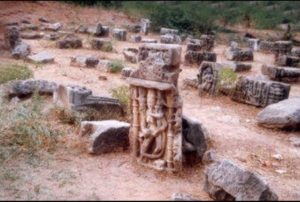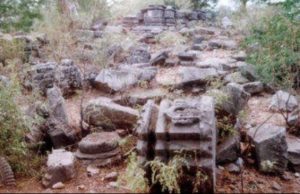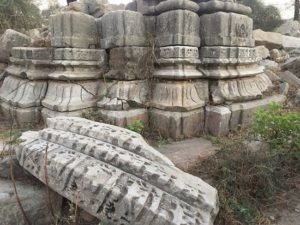Chandravati was ruled by the Parmar Dynasty (Rajput Clan)of Abu. The remains at Chandravati on mount Abu seem to point to the eleventh and twelfth centuries as the time of greatest wealth and splendour . The old ruins temples, torans and hindu god goddess deity scattered over the large area, bear testimony to its past glory. In 1412 A.D great wealth fell into the Muslim invaders Hands, lost almost all independence. Another hundred years completed its ruin. 1411 – 1412 A.D Chandravati has remained forsaken and desolate. Though some are more modern, most of the Chandravati remains belong to the eleventh and twelfth centuries, the best period of Abu architecture (1032-1247).Sahasamala Devada shifted his capital to Sirohi around 1450 AD, and from then on Chandravati lost its glory.

The second season of excavation that commenced from January 12, 2015 spearheaded by Prof J S Kharakwal of JRN Rajasthan Vidyapeeth, Udaipur would continue until the February. The project is a joint venture of the Archaeological department and Rajasthan Vidyapeeth University, Udaipur.
Unit of the research team has spotted craft area of the township along the Sevarni, the southern fringe of the settlement. It is likely that out of three dozen temples a few may belong to craft folks. The exploration unit has also discovered a few watch towers located to the east and south east of the settlement. Line drawing of the temples, craft area, and other complexes is also underway. Members of excavation team are Vineet Godhal, K P Singh, Narayan Paliwal, Rohit Menaria, Rajnikant, Joginder Singh, Baishakhi and Prakash.

As many as three fortified enclosures have been discovered so far. “The largest fortified area, spread in about four hectares, is located in the valley of Banas whereas remaining two forts, about three dozen temples, around a dozen bawaris, besides a very large settlement are located in the valley of Sevarni, a tributary of the Banas. Unfortunately, a major part of the ancient city was destroyed while the Abu Road -Palanpur highway was made,” informed Prof Kharakwal. It has in fact divided the ancient township into two parts.

In 1824 Sir Charles Colville and his team the first European visitors to Chandravati, found twenty marble edifices of different sizes. One Hindu temple was adorned with rich, very well executed sculptured deity and ornaments in high relief, many of the figures almost quite detached. The chief images were of Lord Brahma, two Shiva, Godesses Mahishasurmardini , Yama. Except the roof of the domes, whoso outer marble cover was gone, the temple was white marble throughout, the lustre of tho prominent part undimmed. Near the temple, two richly carved columns, supporting an entablature and sculptured pediment, are probably triumphal pillars. When visited by British explorer Burgess in 1874, of the twenty buildings not more than three or four were left. One temple to Brahma was adorned with rich and finely executed sculptured and ornaments in high relief. Another scholar, Ferguson, found the pillars so highly ornamented in details and varieties that no two pillars are exactly alike. Pillars sketch in 1866. During excavation ASI found two fortifications, a large settlement, about thirty six temples, around twelve bawaris are located in the valley of Sevarni river which is tributary of Banas. The other two fortifications, a large settlement, about thirty six temples, around twelve bawaris are located in the valley of Sevarni river which is tributary of Banas. There were a large number of temples in Chandravati. They were mainly Lord Shiva temples. At present not a single temple is in order. Even its ruins, sold and carried off as building materials, have all but disappeared.

